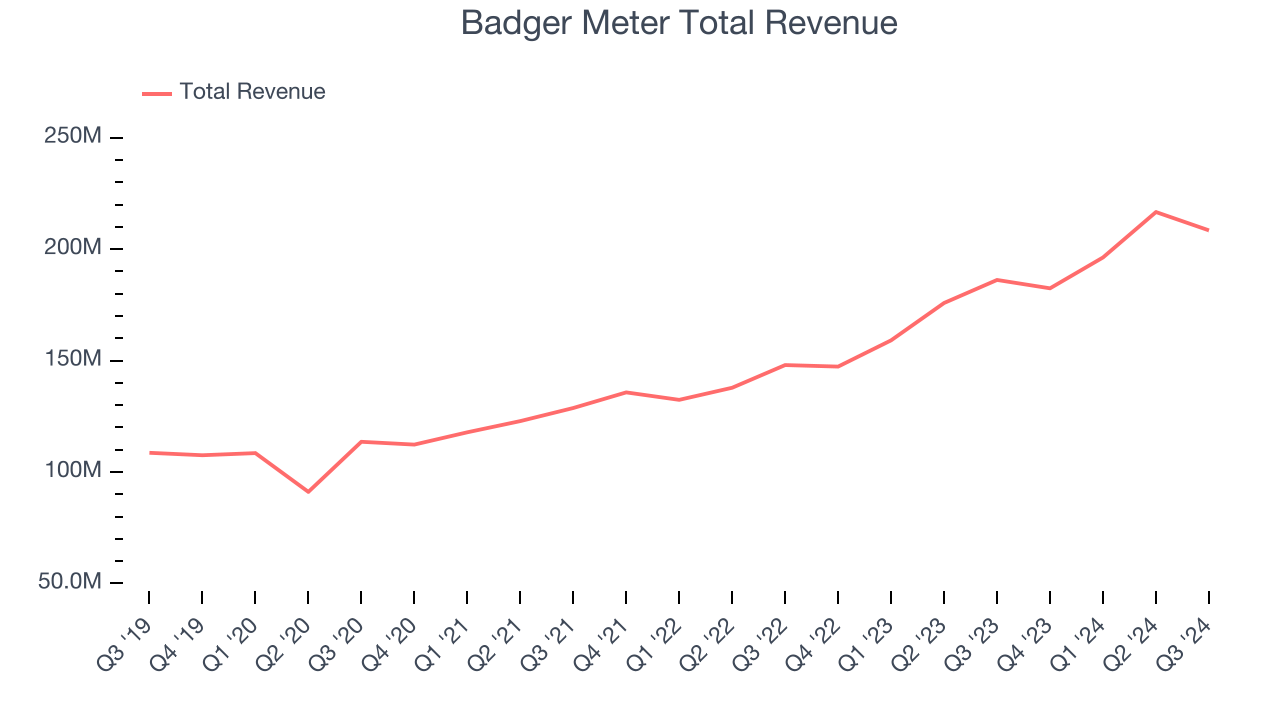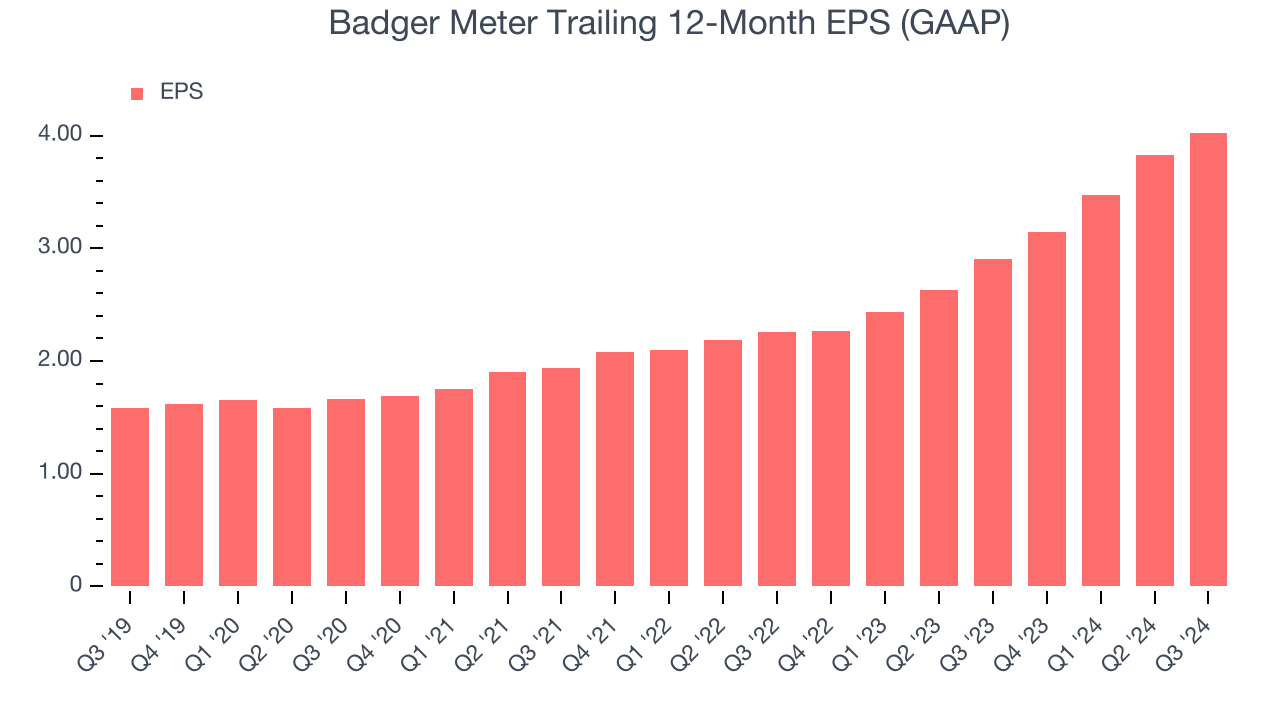Water control and measure company Badger Meter (NYSE:BMI) missed Wall Street’s revenue expectations in Q3 CY2024, but sales rose 11.9% year on year to $208.4 million. Its GAAP profit of $1.08 per share was 6.5% above analysts’ consensus estimates.
Is now the time to buy Badger Meter? Find out by accessing our full research report, it’s free.
Badger Meter (BMI) Q3 CY2024 Highlights:
- Revenue: $208.4 million vs analyst estimates of $212.2 million (1.8% miss)
- EPS: $1.08 vs analyst estimates of $1.01 (6.5% beat)
- "Taking into account our normalizing backlog, strong bid funnel and constructive order rates, we anticipate delivering high single-digit sales growth rates over the cycle, noting the prevailing unevenness common in the industry." (expectation for Q4 revenue growth is 12%)
- Gross Margin (GAAP): 40.2%, up from 39.1% in the same quarter last year
- Free Cash Flow Margin: 20.1%, up from 15.3% in the same quarter last year
- Market Capitalization: $6.46 billion
“We were pleased with our third quarter financial performance delivering strong sales growth, record operating profit margins and robust cash flow generation. Sales in the quarter continued to benefit from solid demand for our tailorable water management solutions. Notably, we achieved record operating profit margins of 19.5%, the result of favorable sales mix, price/cost management, strong operating execution and continued selling, engineering and administration (SEA) expense leverage,” said Kenneth C. Bockhorst, Chairman, President and Chief Executive Officer.
Company Overview
The developer of the world’s first frost-proof water meter in 1905, Badger Meter (NYSE:BMI) provides water control and measure equipment to various industries.
Inspection Instruments
Measurement and inspection instrument companies may enjoy more steady demand because products such as water meters are non-discretionary and mandated for replacement at predictable intervals. In the last decade, digitization and data collection have driven innovation in the space, leading to incremental sales. But like the broader industrials sector, measurement and inspection instrument companies are at the whim of economic cycles. Interest rates, for example, can greatly impact civil, commercial, and residential construction projects that drive demand.
Sales Growth
Examining a company’s long-term performance can provide clues about its business quality. Any business can put up a good quarter or two, but the best consistently grow over the long haul. Over the last five years, Badger Meter grew its sales at an exceptional 13.8% compounded annual growth rate. This is a great starting point for our analysis because it shows Badger Meter’s offerings resonate with customers.

Long-term growth is the most important, but within industrials, a half-decade historical view may miss new industry trends or demand cycles. Badger Meter’s annualized revenue growth of 20.5% over the last two years is above its five-year trend, suggesting its demand was strong and recently accelerated.
This quarter, Badger Meter’s revenue grew 11.9% year on year to $208.4 million, falling short of Wall Street’s estimates.
Looking ahead, sell-side analysts expect revenue to grow 11.1% over the next 12 months, a deceleration versus the last two years. Still, this projection is noteworthy and illustrates the market is factoring in success for its products and services.
Unless you’ve been living under a rock, it should be obvious by now that generative AI is going to have a huge impact on how large corporations do business. While Nvidia and AMD are trading close to all-time highs, we prefer a lesser-known (but still profitable) semiconductor stock benefitting from the rise of AI. Click here to access our free report on our favorite semiconductor growth story.
Operating Margin
Operating margin is an important measure of profitability as it shows the portion of revenue left after accounting for all core expenses–everything from the cost of goods sold to advertising and wages. It’s also useful for comparing profitability across companies with different levels of debt and tax rates because it excludes interest and taxes.
Badger Meter has been a well-oiled machine over the last five years. It demonstrated elite profitability for an industrials business, boasting an average operating margin of 16.5%. This result isn’t surprising as its high gross margin gives it a favorable starting point.
Analyzing the trend in its profitability, Badger Meter’s annual operating margin rose by 3.4 percentage points over the last five years, as its sales growth gave it operating leverage.

In Q3, Badger Meter generated an operating profit margin of 19.5%, up 2.6 percentage points year on year. The increase was encouraging, and since its operating margin rose more than its gross margin, we can infer it was recently more efficient with expenses such as marketing, R&D, and administrative overhead.
Earnings Per Share
We track the long-term growth in earnings per share (EPS) for the same reason as long-term revenue growth. Compared to revenue, however, EPS highlights whether a company’s growth was profitable.
Badger Meter’s EPS grew at an astounding 20.6% compounded annual growth rate over the last five years, higher than its 13.8% annualized revenue growth. This tells us the company became more profitable as it expanded.

We can take a deeper look into Badger Meter’s earnings quality to better understand the drivers of its performance. As we mentioned earlier, Badger Meter’s operating margin expanded by 3.4 percentage points over the last five years. This was the most relevant factor (aside from the revenue impact) behind its higher earnings; taxes and interest expenses can also affect EPS but don’t tell us as much about a company’s fundamentals.
Like with revenue, we analyze EPS over a more recent period because it can give insight into an emerging theme or development for the business. For Badger Meter, its two-year annual EPS growth of 33.6% was higher than its five-year trend. We love it when earnings growth accelerates, especially when it accelerates off an already high base.
In Q3, Badger Meter reported EPS at $1.08, up from $0.88 in the same quarter last year. This print beat analysts’ estimates by 6.5%. Over the next 12 months, Wall Street expects Badger Meter’s full-year EPS of $4.03 to grow by 13.2%.
Key Takeaways from Badger Meter’s Q3 Results
It was good to see Badger Meter beat analysts’ EPS expectations this quarter. On the other hand, its revenue unfortunately missed. Looking ahead, the company called for "high single-digit sales growth", below Consensus expectations, which is calling for 12% growth in Q4. Overall, this was a mediocre quarter. The stock traded down 4.8% to $209 immediately after reporting.
Badger Meter’s earnings report left more to be desired. Let’s look forward to see if this quarter has created an opportunity to buy the stock. When making that decision, it’s important to consider its valuation, business qualities, as well as what has happened in the latest quarter. We cover that in our actionable full research report which you can read here, it’s free.
